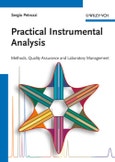This practical book in instrumental analytics conveys an overview of important methods of analysis and enables the reader to realistically learn the (principally technology-independent) working techniques the analytical chemist uses to develop methods and conduct validation. What is to be conveyed to the student is the fact that analysts in their capacity as problem-solvers perform services for certain groups of customers, i.e., the solution to the problem should in any case be processed in such a way as to be "fit for purpose".
The book presents sixteen experiments in analytical chemistry laboratory courses. They consist of the classical curriculum used at universities and universities of applied sciences with chromatographic procedures, atom spectrometric methods, sensors and special methods (e.g. field flow fractionation, flow injection analysis and N-determination according to Kjeldahl).
The carefully chosen combination of theoretical description of the methods of analysis and the detailed instructions given are what characterizes this book. The instructions to the experiments are so detailed that the measurements can, for the most part, be taken without the help of additional literature.
The book is complemented with tips for effective literature and database research on the topics of organization and the practical workflow of experiments in analytical laboratory, on the topic of the use of laboratory logs as well as on writing technical reports and grading them (Evaluation Guidelines for Laboratory Experiments).
A small introduction to Quality Management, a brief glance at the history of analytical chemistry as well as a detailed appendix on the topic of safety in analytical laboratories and a short introduction to the new system of grading and marking chemicals using the "Globally Harmonized System of Classification and Labelling of Chemicals (GHS)", round off this book.
This book is therefore an indispensable workbook for students, internship assistants and lecturers (in the area of chemistry, biotechnology, food technology and environmental technology) in the basic training program of analytics at universities and universities of applied sciences.
The book presents sixteen experiments in analytical chemistry laboratory courses. They consist of the classical curriculum used at universities and universities of applied sciences with chromatographic procedures, atom spectrometric methods, sensors and special methods (e.g. field flow fractionation, flow injection analysis and N-determination according to Kjeldahl).
The carefully chosen combination of theoretical description of the methods of analysis and the detailed instructions given are what characterizes this book. The instructions to the experiments are so detailed that the measurements can, for the most part, be taken without the help of additional literature.
The book is complemented with tips for effective literature and database research on the topics of organization and the practical workflow of experiments in analytical laboratory, on the topic of the use of laboratory logs as well as on writing technical reports and grading them (Evaluation Guidelines for Laboratory Experiments).
A small introduction to Quality Management, a brief glance at the history of analytical chemistry as well as a detailed appendix on the topic of safety in analytical laboratories and a short introduction to the new system of grading and marking chemicals using the "Globally Harmonized System of Classification and Labelling of Chemicals (GHS)", round off this book.
This book is therefore an indispensable workbook for students, internship assistants and lecturers (in the area of chemistry, biotechnology, food technology and environmental technology) in the basic training program of analytics at universities and universities of applied sciences.
Table of Contents
IINTRODUCTIONAnalytical Chemistry - The History
Analytical Chemistry and Its Role in Today's Society
INTRODUCTION TO QUALITY MANAGEMENT
Historical Background
Variability
The Four Pillars of Wisdom (from Shewhart to Deming)
Zero-Defect Tolerance
Why Standards?
The Controlled Process
ISO Guidelines 9004
Quality Management System (QMS) Requirements
FUNDAMENTALS OF STATISTICS
Basic Concepts
Important Terms
Quality of Results (Accuracy and Precision)
Regression
THE ANALYTICAL PROCESS
The Analytical Process in the Overall Context
Planning Phase
Analysis
Assessment
Validation
Final Documentation
EXAMPLE OF A VALIDATION STRATEGY
Determination of Phenol in Industrial Waste Water
ORGANIZATIONAL AND PRACTICAL PROCEDURES IN THE TEACHING LABORATORY PROGRAM
Goals
Safety in the Laboratory Class
Experimental Project Workflow
Reports
LITERATURE
Cited Literature
Recommended Norms (Selection)
Suggested Books (Selection)
PROJECTS
Chromatography
Spectroscopy
Electrophoretic Separation Methods
Automation
Mass Analytical Determination Methods
General Analytical Methods
7 Universal Separation Methods
APPENDIX A SELECTION OF RECOMMENDED SOURCES BY SUBJECT AREA
APPENDIX B STATISTICAL TABLES
APPENDIX C OBLIGATORY DECLARATION FOR STUDENTS
APPENDIX D THE INTERNATIONAL SYSTEM OF UNITS (SI) - AND THE 'NEW SI'
APPENDIX E EVALUATION GUIDE FOR FORMAL REPORTS
APPENDIX F SAFETY IN THE ANALYTICAL LABORATORY
INDEX








